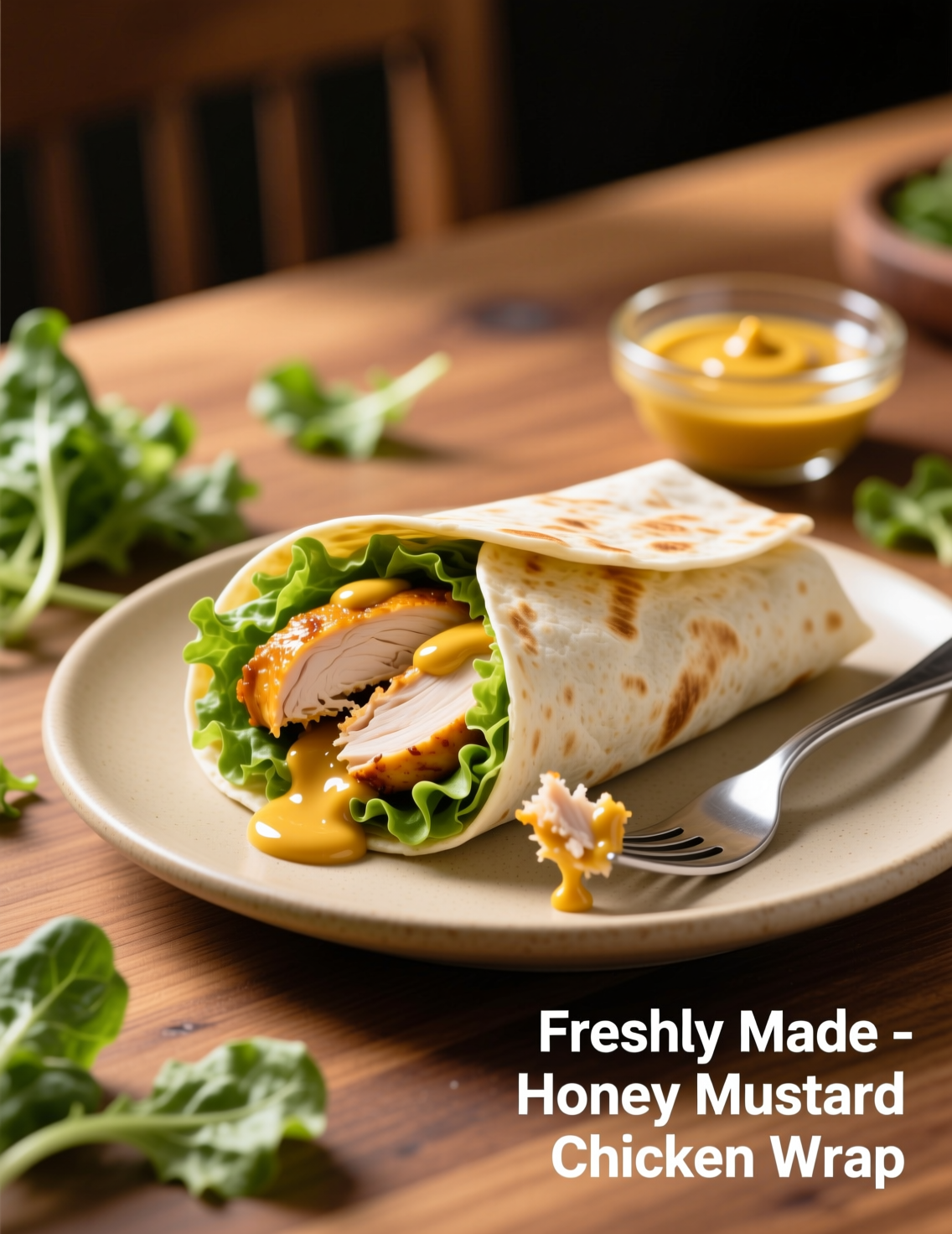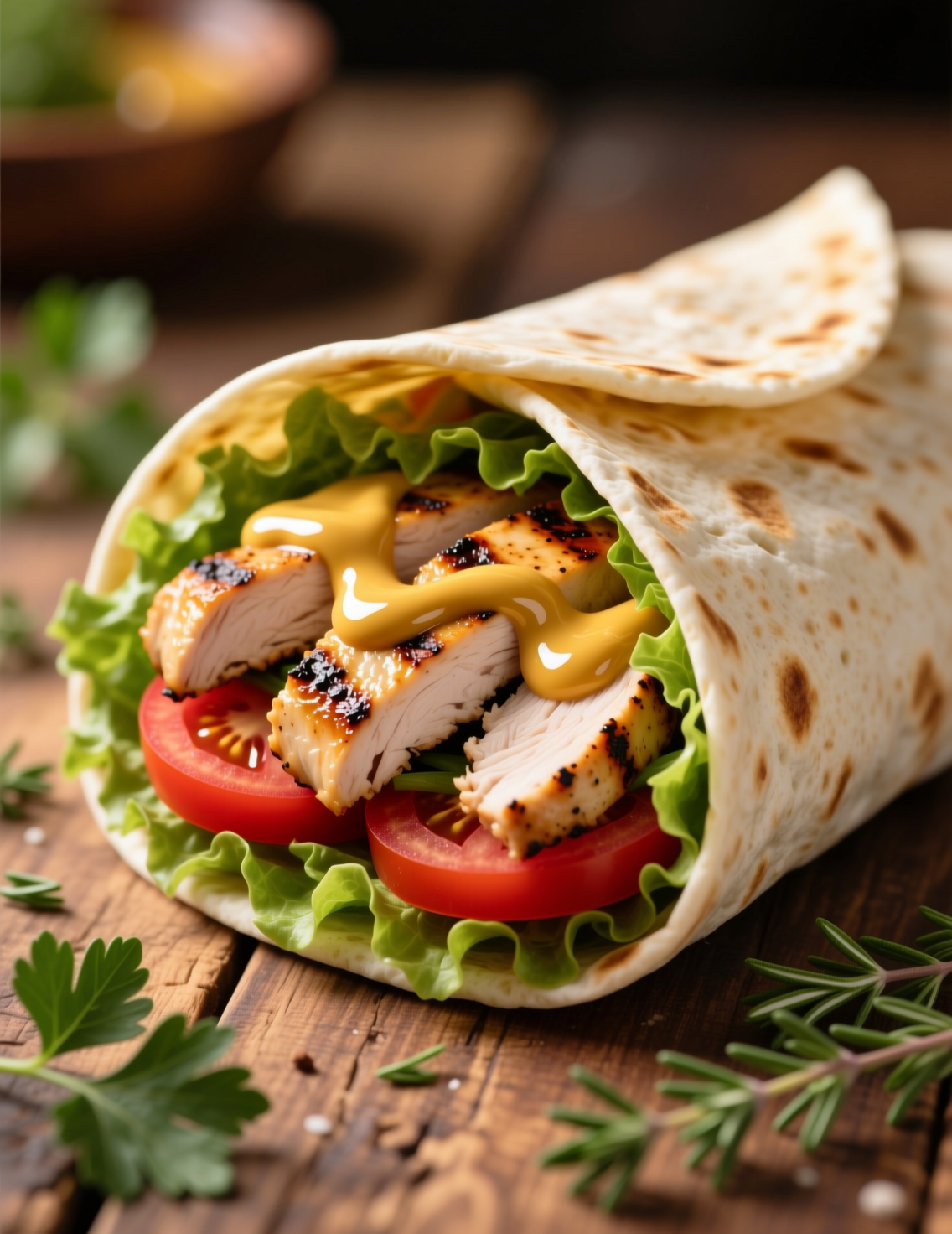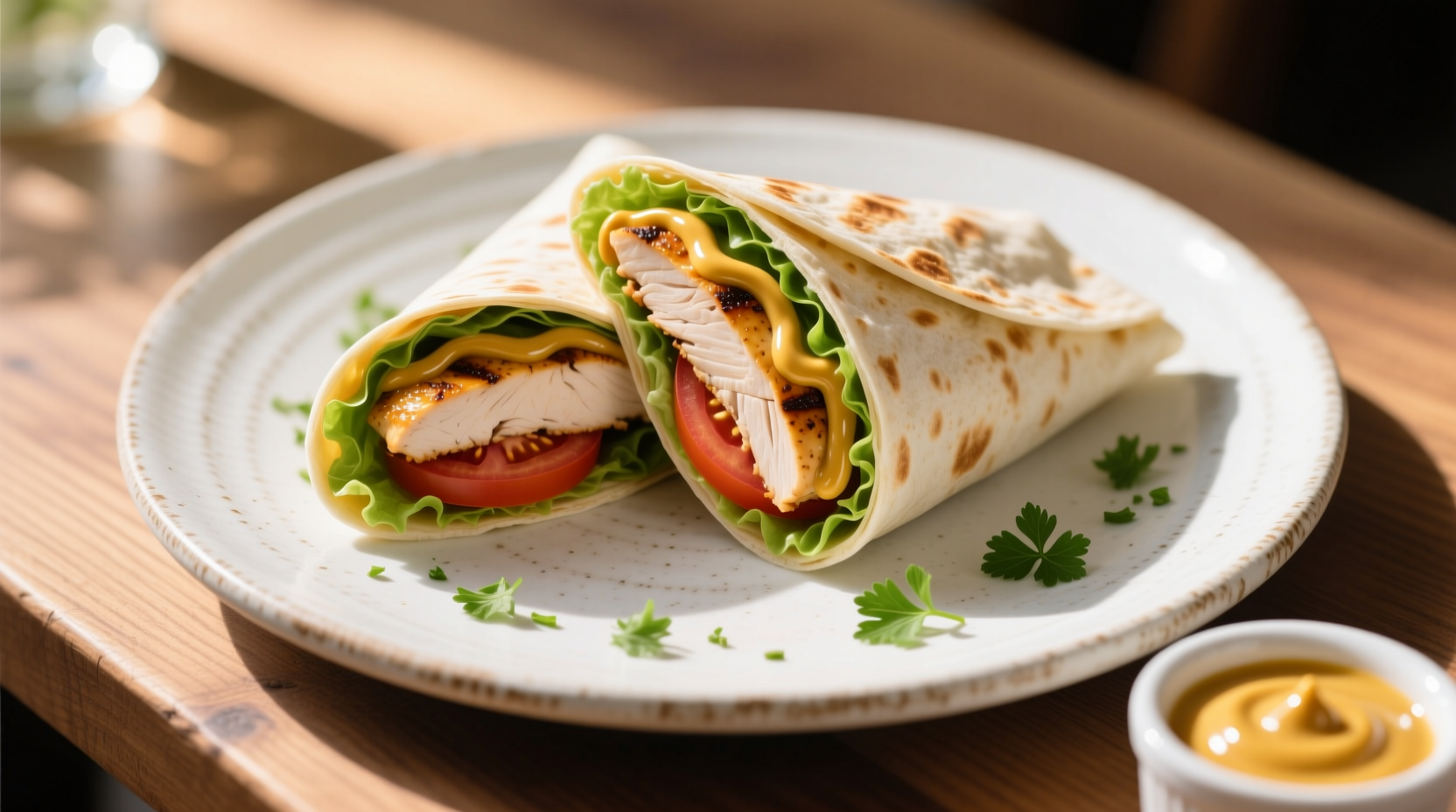There’s something very deceptive about a wrap. It looks simple, you roll it up and call it lunch. But when you dig in as a cook or a food professional, you realize a wrap is a study in balance. This Easy Honey Mustard Chicken Wrap recipe for 4 servings proves just that—sweetness, tang, creaminess, and crunch all woven together in one bite. What makes it exciting isn’t just that it’s easy. It’s that it teaches us how flavor layers can elevate ordinary ingredients into something that keeps people coming back.
Why Wraps Work in Professional Kitchens
Wraps have become more than just quick eats for students and office workers. They are a reliable option in professional food service because they’re portable, cost-efficient, and customizable. According to Technomic’s 2024 Menu Trends Report, handhelds like wraps make up nearly 20% of fast-casual lunch orders in the U.S. That’s not small potatoes.
And here’s the trick: people crave something light but filling. Wraps bridge that gap. Unlike burgers or heavy sandwiches, they deliver flavor without weighing the eater down. This is why chefs from hotel buffets to campus dining halls keep wraps as a constant. Honey mustard chicken wraps? A bestseller, no matter the demographic.
Ingredients That Matter
You could toss any old chicken and mustard into a tortilla and call it a wrap. But you’d miss the point. The craft lies in the small choices.
- Chicken breast, 2 large (about 1 lb) – Lean protein, quick to cook, and holds marinades well.
- Honey, 3 tablespoons – Natural sweetness that mellows the mustard’s sharpness.
- Dijon mustard, 3 tablespoons – A bit of heat, a bit of tang. Don’t swap with plain yellow unless you want flat flavors.
- Mayonnaise, 2 tablespoons – Not much, just enough to cream out the dressing.
- Garlic powder, 1 teaspoon – Subtle but builds depth.
- Smoked paprika, 1 teaspoon – Gives the chicken a warm backnote.
- Salt and black pepper, to taste – The usual but never optional.
- Large flour tortillas, 4 – The foundation; 10-inch size wraps best.
- Romaine lettuce, shredded, 2 cups – Crunch is non-negotiable here.
- Red onion, thinly sliced, ½ cup – Sharp bite, needed for contrast.
- Shredded cheddar cheese, 1 cup – Melts into the warm chicken.
Notice what’s missing? Tomatoes. They often make wraps soggy, especially if prepped ahead. Professional tip: if you must use them, deseed and dry well.

Preparing the Chicken Right
Cooking chicken for wraps is more than searing protein. The aim is tenderness, because no one wants chewy bites in a handheld dish. Marinate the chicken breasts with olive oil, garlic powder, paprika, salt, and pepper for at least 20 minutes. This isn’t only about flavor. It helps moisture retention during cooking, which is critical if the wraps need to hold for service.
Pan-searing is the most efficient method for 4 servings. Heat a heavy skillet, sear each side for 5 minutes, then cover and let it rest off-heat. The rest step is overlooked in home kitchens but sacred in pro ones. The juices redistribute, meaning every slice stays moist.
Honey Mustard Dressing – The Balancing Act
The dressing is the real star here. Honey and Dijon mustard in equal measure, plus a spoonful of mayo to thicken and carry flavors across the palate. Whisk until smooth. Taste and adjust—sometimes the honey feels too strong depending on the batch. A drop of vinegar can cut it.
Professionals know sauces define dishes. This dressing works beyond the wrap: as a dip for chicken fingers, a glaze for grilled pork, or even a base for slaws. A chef might make a quart and use it in three different applications in one service. That’s efficiency and flavor economy.
Assembling the Wraps
Assembly is not casual. Placement matters because it determines how the wrap eats. Lay out the tortilla flat. Spread a tablespoon of honey mustard dressing in the center, not edge to edge, otherwise it leaks. Layer lettuce, then chicken slices, then onions, and finally cheese.
Always layer from crunch to soft. Lettuce forms a barrier to keep tortilla from sogging. Cheese goes near the top to melt slightly on warm chicken. Fold the sides first, then roll tight. Slice diagonally. Why diagonally? Better plate appeal, easier bite, and psychologically it feels like more food.
Scaling for Service
For professionals cooking beyond the family table, scaling is key. This recipe scales neatly for 20 wraps by multiplying ingredients by 5. However, two adjustments are needed. First, keep chicken warm in hotel pans over gentle steam, not dry heat. Second, always store dressing separately until assembly. Premixed wraps with sauce sog within 30 minutes.
Cafés often prepare components separately and assemble on order, ensuring freshness. In banquet settings, wraps may be assembled in advance but kept chilled, then tightly wrapped in plastic until service. The honey mustard dressing helps here—it clings well and doesn’t weep like vinaigrettes.
Nutritional Profile and Market Demand
Each wrap clocks in around 450–500 calories, with 30 grams of protein, moderate fat, and controlled carbs depending on tortilla choice. Compared to fried chicken sandwiches or loaded burgers, this option appeals to health-conscious diners.
A 2023 Statista survey showed that 63% of consumers aged 25–40 actively seek “balanced fast food” options. Wraps, especially those with chicken and fresh veg, hit that sweet spot. Restaurants use this as a menu anchor—a healthier option that still tastes indulgent.
Common Mistakes and Fixes
Professionals and home cooks alike often trip on the same issues. Overcooking the chicken is the biggest offender. Dry meat ruins wraps, no matter how good the dressing. Solution: use a probe thermometer, pull at 160°F, and rest until carryover heat brings it to 165°F.
Another issue? Wraps falling apart. That comes from overfilling. Less is more. Each bite should taste of every element, not just chicken or just lettuce. For service, sometimes tortillas are briefly warmed before use, making them pliable and easier to fold tightly.

Variations That Work
The honey mustard base welcomes improvisation. Some chefs swap chicken for turkey breast or roasted chickpeas for a vegetarian version. Add roasted bell peppers for smokiness or swap cheddar with Swiss for a milder wrap.
Street food vendors in the Middle East adapt the wrap with flatbreads and tahini-honey sauces, creating a fusion that still respects the balance of sweet and tang. College dining halls often use whole wheat tortillas and Greek yogurt in place of mayo, trimming calories while boosting protein.
Professional Insights on Pairing
What do you serve with a wrap? Not fries, if you’re thinking in balance terms. Chefs often pair with side salads, fruit cups, or light soups. The wrap itself has carbs, protein, fat, and veg. Pairing it with heavy sides breaks the equilibrium.
From a beverage perspective, unsweetened iced tea works brilliantly. The tannins balance the honey sweetness. For restaurants with alcohol menus, a crisp Sauvignon Blanc or a light lager makes an ideal match. Small decisions like this shape the diner’s perception of value.
Storage and Meal Prep Considerations
If prepping ahead for 4 servings, store chicken and dressing separately. Wraps can be assembled up to 4 hours in advance if tightly wrapped and chilled. Beyond that, the lettuce wilts and tortilla softens unpleasantly.
Meal prep professionals recommend layering in this order for storage: tortilla, cheese, chicken, onion, lettuce last. When rolled, the lettuce becomes outermost against the tortilla, creating a moisture barrier. It’s a neat reversal but works wonders for fridge life.
The Emerging Trend of Sweet-Savory Wraps
Honey mustard fits into a broader trend. Sweet-savory profiles dominate current flavor innovations. Datassential’s 2024 Flavors of the Year highlighted “sweet heat” and “honey-based sauces” as high-growth categories, particularly in handheld formats.
Professional kitchens can leverage this by offering rotating wraps with honey-chipotle, maple-mustard, or sriracha-honey glazes. Consumers respond to novelty in familiar forms. Wraps are the perfect carrier for that experimentation.
Final Thoughts
This Easy Honey Mustard Chicken Wrap recipe for 4 servings isn’t just about feeding a small group. It’s a micro-lesson in balance, technique, and how simple dishes can hold professional weight. The chicken must stay juicy. The dressing must balance sharp and sweet. The assembly must respect structure.
For professionals, this dish is versatile, scalable, and appeals to a broad customer base. For home cooks, it’s quick enough for a weeknight but elegant enough for entertaining. Either way, it shows how even the humblest wrap can carry the weight of craft.
FAQs
What is the serving size for this Honey Mustard Chicken Wrap recipe?
The recipe makes 4 servings, perfect for a small group or family lunch.
Can I use chicken thighs instead of chicken breasts?
Yes, thighs work, but cook slightly longer for tenderness.
How long should I marinate the chicken?
At least 20 minutes for flavor and moisture retention.
Can I make the wraps ahead of time?
Yes, but store chicken and dressing separately to prevent sogginess.
What kind of mustard is best for this recipe?
Dijon mustard gives the perfect balance of tang and mild heat.
Can I substitute mayonnaise in the dressing?
Greek yogurt works as a healthier alternative with a similar creaminess.
How do I prevent the wrap from falling apart?
Avoid overfilling and fold the sides before rolling tightly.
What sides pair well with this wrap?
Light salads, fruit cups, or soups complement it best.
Can this recipe be scaled for larger groups?
Yes, multiply ingredients as needed but keep dressing separate until assembly.
Is this recipe suitable for meal prep?
Yes, assemble shortly before eating for best texture and freshness.

Mariana is a passionate home cook who creates delicious, easy-to-follow recipes for busy people. From energizing breakfasts to satisfying dinners and indulgent desserts, her dishes are designed to fuel both your body and hustle.
When she’s not in the kitchen, she’s exploring new flavors and dreaming up her next recipe to share with the Foodie Hustle community.

